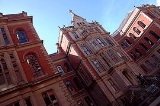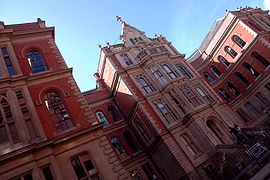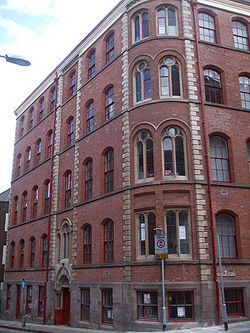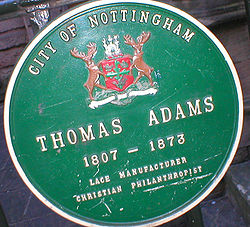
The Adams Building Nottingham
Encyclopedia




Lace Market
The Lace Market is an historic quarter-mile square area of Nottingham, England.Once the heart of the world's lace industry during the days of the British Empire, it is full of impressive examples of 19th century industrial architecture and thus is a protected heritage area...
district of Nottingham
Nottingham
Nottingham is a city and unitary authority in the East Midlands of England. It is located in the ceremonial county of Nottinghamshire and represents one of eight members of the English Core Cities Group...
, England
England
England is a country that is part of the United Kingdom. It shares land borders with Scotland to the north and Wales to the west; the Irish Sea is to the north west, the Celtic Sea to the south west, with the North Sea to the east and the English Channel to the south separating it from continental...
.
Background
Historically, it is probably the largest and finest example of a VictorianVictorian architecture
The term Victorian architecture refers collectively to several architectural styles employed predominantly during the middle and late 19th century. The period that it indicates may slightly overlap the actual reign, 20 June 1837 – 22 January 1901, of Queen Victoria. This represents the British and...
lace warehouse to survive in the country, and has been listed by the Department of Culture, Media and Sport as Grade II* (of architectural or historical interest). The building now forms part of the City campus of New College Nottingham
New College Nottingham
New College Nottingham is an amalgamation of education establishments in the City of Nottingham. The College caters for students from the age of 14 and has several campuses throughout the Nottingham conurbation, primarily in the City itself...
.
Opened on 10 July 1855, the building is named after its original owner Thomas Adams
Thomas Adams (manufacturer and philanthropist)
- Early Years :Thomas Adams was born at Worksop, Nottinghamshire on 5 February 1807. His father was a maltster, a trade in the doldrums at that time. Not long after Thomas' birth, the family moved to Ware, Hertfordshire to try and improve their situation...
(1817–1873), a Victorian industrialist with strong Quaker views and a deep social conscience. He selected the Nottingham architect Thomas Chambers Hine
Thomas Chambers Hine
Thomas Chambers Hine 1814 - 1899 was an architect based in Nottingham.He was born in Covent Garden into a prosperous middle class family, the eldest son of a hosiery manufacturer. He was articled to the London architect Matthew Habershorn. In 1837 he arrived in Nottingham and formed a partnership...
and between them, they created a building which, for a variety of social and architectural reasons, is quite unique.
Phase I
As it now exists, the Adams Building is the product of several distinct phases of construction from 1854 to around 1874. The earliest phase is the building facing Stoney Street, with its elaborate symmetrical frontage behind a railed courtyard. It was designed as a lace showroom and warehouse, in which lace products brought in from outlying factories were finished off and then sold. The main display area seems to have been a spectacular two-storey lightwell in the centre of the building (now sadly closed up), originally lit by decorative gas lamps; approached by a grand staircase. Secondary areas were used for mending and packing. The main power source was a steam engine to the rear, with hydraulic engines for the hoists and packing machines.Maximum lighting was provided for the lace repair and finishing shops. Hine provided 'lace lofts' at roof level whose walls were almost entirely built from glass. These lace lofts were innovative in their time and quickly became a characteristic of Nottingham's then-thriving lace manufacturing industry, and this architectural motif can still be seen (along with more modern interpretations) throughout the Lace Market today.
As a committed Christian
Christian
A Christian is a person who adheres to Christianity, an Abrahamic, monotheistic religion based on the life and teachings of Jesus of Nazareth as recorded in the Canonical gospels and the letters of the New Testament...
and philanthropist, Thomas Adams was determined to provide humane conditions and good facilities for his workforce. A large area of the basement (now Floor B) was designed as a chapel (with a company chaplain and vestry) where more than 500 workers and managers would take part in a service before starting work. Indoor toilets, washing facilities and tea rooms were provided for staff, and there are records of a sick fund, savings bank and book club.
Heating was provided by a mixture of coal and patent warm-air flues brought through ducts from a heat exchanger at the boiler. These amenities were at the forefront of mid-Victorian factory design, and the Adams factory was regarded as a model example of its kind by contemporary factory inspectors.
The architecture of Phase I
TC Hine adopted a distinctly 'Anglo-Italian' style for the principal elevations. In places, this appears redolent of the 15th century Palazzo Ricardi in FlorenceFlorence
Florence is the capital city of the Italian region of Tuscany and of the province of Florence. It is the most populous city in Tuscany, with approximately 370,000 inhabitants, expanding to over 1.5 million in the metropolitan area....
, Italy
Italy
Italy , officially the Italian Republic languages]] under the European Charter for Regional or Minority Languages. In each of these, Italy's official name is as follows:;;;;;;;;), is a unitary parliamentary republic in South-Central Europe. To the north it borders France, Switzerland, Austria and...
. His chosen materials were plain brick, moulded brick and local Derbyshire and Ancaster
Ancaster, Lincolnshire
Ancaster is a village in the South Kesteven district of Lincolnshire, England, on the site of the Roman town of "Causennae"Ancaster Hall at The University of Nottingham is named after the parish and the, now extinct, title of the Earl of Ancaster....
stone (often exchanged for rendering at high levels for economy. but done so one cannot really notice, certainly not from street-level anyhow).
By giving a high priority to the appearance of the elevations, Hine had to adjust the level of some of the internal floors, and on occasion, allow the floors to cut across windows, so as not to spoil the overall intended effect.
The sheer size and grandeur of the building must have caused astonishment when it opened, not least because of the contrast with the other plainer industrial buildings in the vicinity. A local newspaper described it as the 'finest erection in the Midlands!'
Later phases
The building was later extended along St Mary's Gate to the rear, and finally, along Warser Gate. In the process, this incorporated a building at the end of King's Place. Although externally, this appears to be of minor interest, this is a rare survivor of a tenement lace or hosiery factory, dating from the early 19th Century. It was used at various times in its early life as a Roman Catholic chapel.These later blocks were much more plain and functional, and it is possible that they were built speculatively, perhaps for rent as tenement lace factories.
Extra steam engines were installed to serve these new blocks, and massive cast-iron doors fitted at intersecting walls to prevent the spread of fire. (Some of these fireproofing doors remain in-situ, and have become part of the fabric of the restored building).
An ingenious heating and ventilation system was installed in the later blocks, using fresh air from wall ventilators drawn over hot steam pipes. Hine continued to experiment structurally, the timber floor beams of the original building giving way progressively to cast-iron beams, rivetted wrought-iron girders, rolled-iron beams and (possibly) early mild-steel beams, as each of these materials became available. The Adams Building therefore, illustrates technical and structural evolution over a particularly interesting period.
As completed, the complex had 113,000 square feet (10,500 square metres) of floorspace over 6 floors, 8 principal staircases and 3 minor staircases.
Over the intervening years, many alterations were made, especially the addition of new goods lifts, the replacement of the original (and highly ornate) boiler chimney, the removal and insertion of staircases, and internal conversions.
On St Mary's Gate, the decorative turret and clocktower above the main entrance stairwell was replaced by a lift motor room crudely built in brick.
During World War II
World War II
World War II, or the Second World War , was a global conflict lasting from 1939 to 1945, involving most of the world's nations—including all of the great powers—eventually forming two opposing military alliances: the Allies and the Axis...
, concrete bomb shelters were built in the Stoney Street courtyard, obscuring the basement walls, and the occupation of the ground floor by the RAF for parachute storage caused serious damage to the floor and chapel below. The Adams Company closed the factory in 1950, and the building was sub-divided into what quickly became a poorly-maintained warren of small businesses.
Restoration and reuse
Until recently, the Adams Building was in a serious state of decline, due to rising repair costs, outdated standards of workspace, and under-occupation. Many floors were structurally unsound, having sagged or failed under the weight of heavy machinery.In 1996, the building was acquired by the Lace Market Heritage Trust, and after being considered for the new headquarters of English Heritage
English Heritage
English Heritage . is an executive non-departmental public body of the British Government sponsored by the Department for Culture, Media and Sport...
was restored and converted to a new use as a College of Further and Higher Education for New College Nottingham
New College Nottingham
New College Nottingham is an amalgamation of education establishments in the City of Nottingham. The College caters for students from the age of 14 and has several campuses throughout the Nottingham conurbation, primarily in the City itself...
. Many of the courses held here (such as fashion and textiles) continue the traditional purpose of the building for the design and manufacture of clothing.
The £16.5 million restoration of the Adams Building itself triggered a revitalisation of the Lace Market
Lace Market
The Lace Market is an historic quarter-mile square area of Nottingham, England.Once the heart of the world's lace industry during the days of the British Empire, it is full of impressive examples of 19th century industrial architecture and thus is a protected heritage area...
district as a whole. The project was assisted by grant aid from the Heritage Lottery Fund
Heritage Lottery Fund
The Heritage Lottery Fund is a fund established in the United Kingdom under the National Lottery etc. Act 1993. The Fund opened for applications in 1994. It uses money raised through the National Lottery to transform and sustain the UK’s heritage...
and European Regional Development Fund
European Regional Development Fund
The European Regional Development Fund is a fund allocated by the European Union.-History:During the 1960s, the European Commission occasionally tried to establish a regional fund. Only Italy ever supported this, however, and nothing came of it. Britain made it an issue for their accession in...
, and was a pilot scheme for the Government's Private Finance Initiative
Private Finance Initiative
The private finance initiative is a way of creating "public–private partnerships" by funding public infrastructure projects with private capital...
. CPMG Architects designed the refurbishment.
The Adams Building was officially reopened by HRH the Prince of Wales
Charles, Prince of Wales
Prince Charles, Prince of Wales is the heir apparent and eldest son of Queen Elizabeth II and Prince Philip, Duke of Edinburgh. Since 1958 his major title has been His Royal Highness The Prince of Wales. In Scotland he is additionally known as The Duke of Rothesay...
on 5 February 1999.
The Queen's Anniversary Prize
In 2002, New College Nottingham was awarded the Queen's Anniversary Prize for Higher and Further EducationQueen's Anniversary Prize
The Queen's Anniversary Prizes for Higher and Further Education is a biennially awarded series of prizes awarded to Universities and Colleges in the further and higher education sectors within the United Kingdom...
. The official citation for the award reads as follows:
Further reading
- Brand, Ken (2003). Thomas Chambers Hine: architect of Victorian Nottingham. Nottingham: Nottingham Civic SocietyNottingham Civic SocietyThe Nottingham Civic Society is a civic society based in the city of Nottingham, England.The society was founded in 1962 and aims to care for the city of Nottingham, especially with respect to its historic buildings and heritage. Meetings are held in St Barnabas Cathedral Hall.- External links :*...
. ISBN 190244308X. - Harwood, Elain (2008). Nottingham (Pevsner Architecture Guide). New Haven and London: Yale University PressYale University PressYale University Press is a book publisher founded in 1908 by George Parmly Day. It became an official department of Yale University in 1961, but remains financially and operationally autonomous....
. ISBN 978-0-300-12666-2.

